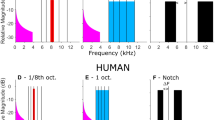Abstract.
Four squirrel monkeys (Saimiri sciureus) were tested for their frequency discrimination capacity using an eyeblink classical conditioning procedure, with air puff against the eye as unconditioned stimulus and 600-ms pure tones as conditioned stimuli. Absolute frequency difference thresholds showed a minimum (20–41 Hz, mean 30 Hz) at 4,000–8,000 Hz and increased towards higher as well as lower frequencies (70–90 Hz, mean 80 Hz at 300 Hz; 44–120 Hz, mean 82 Hz at 16,000 Hz). Relative frequency difference thresholds increased from higher to lower frequencies, with values as low as 0.3–0.8% (mean 0.5%) at 16,000 Hz and as large as 24–30% (mean 27%) at 300 Hz. The squirrel monkey's frequency discrimination function thus shows a severe deviation from Weber's law. The frequency difference thresholds are comparable to human's in the 4,000–8,000 Hz range, but are 65–80 times higher in the 500- to 300-Hz range. Individuals with high auditory thresholds do not necessarily also have high frequency difference thresholds.
Similar content being viewed by others
Author information
Authors and Affiliations
Additional information
Electronic Publication
Rights and permissions
About this article
Cite this article
Wienicke, .A., Häusler, .U. & Jürgens, .U. Auditory frequency discrimination in the squirrel monkey. J Comp Physiol A 187, 189–195 (2001). https://doi.org/10.1007/s003590100189
Accepted:
Issue Date:
DOI: https://doi.org/10.1007/s003590100189




